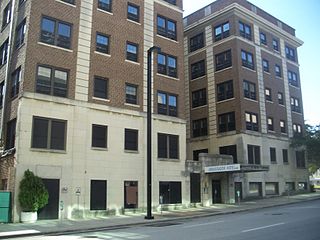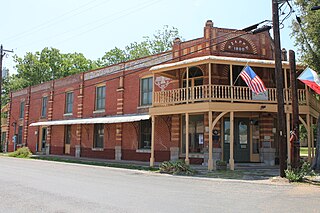S. H. Kress & Co. was the trading name of a chain of five and dime retail department stores in the United States established by Samuel Henry Kress. It operated from 1896 to 1981. In the first half of the 20th century, there were Kress stores with ornamented architecture in hundreds of cities and towns.

The Lightner Museum is a museum of antiques, mostly American Gilded Age pieces, housed within the historic Hotel Alcazar building in downtown St. Augustine. This 1887 Spanish Renaissance Revival style building is listed on the National Register of Historic Places.

The Forks is a historic site, meeting place, and green space in downtown Winnipeg located at the confluence of the Red River and the Assiniboine River.

The 310 West Church Street Apartments, also known as the Ambassador Hotel, is a historic building located at 420 North Julia Street in Jacksonville, Florida, United States. On April 7, 1983, it was added to the U.S. National Register of Historic Places.

Deetjen's Big Sur Inn, a collection of single wall buildings, cabins, and a restaurant in Castro Canyon, was one of the first visitor accommodation to offer overnight lodging and meals to Big Sur, California visitors and travelers after the opening of Highway 1 in 1937. Helmuth Deetjen initially built cottages for others in Carmel, and was attracted to the Big Sur coast that reminded him of Norway. In 1926, he bought 6 acres (2.4 ha) and began construction of a home. He met Helen Haight and when Highway 1 was completed in 1937, they opened an inn. Helmuth managed the Inn until his death in October 1972, when its operation passed to a non-profit foundation. The Inn was closed for a short time after the Soberanes Fire and subsequent winter floods damaged several structures.

The Sheridan Inn is a historic hotel in Sheridan, Wyoming. Designed by the architect Thomas R. Kimball of Omaha, Nebraska in 1893, it was constructed by the Chicago, Burlington, and Quincy Railroad as part of its development program in Wyoming associated with extension of the railway. Equipped with the first bathtubs and electric lights in that part of Wyoming, the inn was considered the "finest hotel" between Chicago and San Francisco. It was declared a National Historic Landmark in 1964.
Merritt H. Starkweather (1891–1972) was a Tucson, Arizona, architect and civic leader. A native of Oshkosh, Wisconsin, after visiting the Panama-California Exposition (1915), he moved to Tucson and began working in an elegantly simplified Spanish Colonial Revival Style architecture. Several of his works are listed for their architecture on the National Register of Historic Places.

The Dearborn Inn, A Marriott Hotel is a historic hotel in the suburban city of Dearborn, Michigan in Metro Detroit. It opened in 1931 and closed in February 2023 for renovations. It was conceived by Henry Ford, who saw a need for food and accommodations for visitors flying into the nearby Ford Airport, making it one of the first airport hotels. It is located at 20301 Oakwood Boulevard near The Henry Ford and the world headquarters building of Ford Motor Company. Albert Kahn designed the Dearborn Inn in the Georgian architectural style. The Dearborn Inn is owned by Ford Motor Land Development Corporation and managed by Marriott International.

William Lee Stoddart (1868–1940) was an architect who designed urban hotels in the Eastern United States. Although he was born in Tenafly, New Jersey, most of his commissions were in the South. He maintained offices in Atlanta and New York City.

The Dallas Hilton, constructed as the Hilton Hotel and today operating as the Hotel Indigo Dallas Downtown, is a historic hotel opened in 1925, located at the corner of Main Street and S. Harwood Street in downtown Dallas, Texas (USA). The hotel is a contributing property in the Harwood Street Historic District and Main Street District. It is also located across the street from Main Street Garden Park.

The Town Farms Inn is a historic poor farm on Silver Street at River Road in Middletown, Connecticut. It was listed on the National Register of Historic Places in 1979. The poor farm provided employment and food for indigent people.

The New Inn, 16 Northgate Street, Gloucester, England, is a timber framed building used as a public house, hotel and restaurant. It is the most complete surviving example of a medieval courtyard inn with galleries in Britain, and is a Grade I listed building. The announcement of Lady Jane Grey's succession to the English throne was made from the Inn gallery in 1553.

The College Inn is a nationally recognized historic building in Seattle. It is located at the Northeast corner of University Way ne and NE 40th Street in the University District one block west of the University of Washington. Built by local developer Charles Cowen, It was designed in 1909 by Graham & Myers and is an excellent example of Tudor Revival architecture used on a commercial building. Graham & Myers would design at least 50 houses for Cowen's University Park subdivision. At the time of its construction, the university campus was the site of the Alaska–Yukon–Pacific Exposition and Ye College Inn was intended to function as a small hotel for fairgoers. It later provided housing for students as well as commercial services on the lower floor. Currently it houses a boutique hotel, three cafes, and a pub. Following a complete restoration in 1979, The College Inn was listed on the National Register of Historic Places in 1982.

S. Walker's Hotel, also known as the Brick Walker Tavern, is a former hotel/tavern located at 11705 US-12 in Cambridge Township, Michigan. It was listed on the National Register of Historic Places in 2007. The hotel is notable for its brick exterior and three-story height - most other surviving early brick tavern/hotel buildings in Michigan are two-story frame structures. The building is currently operated as an event space known as the "Brick Walker Tavern."

The St. Clair Inn is a hotel located at 500 North Riverside Avenue in St. Clair, Michigan. It was listed on the National Register of Historic Places in 1995.

The Zapp Building, later known as the Country Place Hotel and Restaurant, is a historic building in Fayetteville, Texas, United States. It was built in 1900 by builders Stidham and Kurtz in the Romanesque Revival style for local merchant Hugo Zapp to replace a wooden building at the site which burned down. Zapp bought a shop at this prominent location at the northwest corner of the town square in 1876. It was added to the National Register of Historic Places on June 23, 1983, and designated a contributing property to the Fayetteville Historic District by the registrar on July 10, 2008.

Historic Hotels of America is a program of the National Trust for Historic Preservation that was founded in 1989 with 32 charter members; the program accepts nominations and identifies hotels that have maintained their authenticity, sense of place, and architectural integrity. In 2015, the program included over 260 members in 44 states, including the District of Columbia, Puerto Rico, and the U.S. Virgin Islands. In 2022, the program includes 273 hotels. This article lists current and former member hotels.

El Paseo Building is a two-story commercial building in downtown Carmel-by-the-Sea, California. The building is the best example of Spanish Eclectic commercial design in Carmel, inspired by the Spanish churches built in the 1880s. The building was designated in the city's Downtown Historic Conservation District Historic Property Survey on January 24, 2002. The building has been occupied by the Little Napoli restaurant since 1990.

The Sundial Lodge, also known today as the L’Auberge Carmel, a Relais & Châteaux property, is a historic Medieval Revival hotel in Carmel-by-the-Sea, California. It was designed by architect Albert L. Farr of San Francisco Bay Area and was built in 1929–1930, by Master builder Michael J. Murphy. It was designated as an important commercial building in the city's Downtown Historic District Property Survey, and was recorded with the Department of Parks and Recreation on December 5, 2002.

The Meeting Street Inn, is in the Charleston Historic District at 174 Meeting Street in downtown Charleston, South Carolina. The building is unusual in its history that dates to 1837 when it was occupied by the Charleston Theatre. In 1874, businessman Enoch Pratt bought the property and built a three-story brick building. It was built in the traditional Charleston style, and had running water piped throughout the building, an innovation for that time. The building turned into the Meeting Street Inn in 1981. The property was acquired by innkeeper Frances F. Limehouse in 1992, who made extensive renovations to develop the Inn as a luxury hotel. The renovations helped to bring in a modern restoration movement that transformed Charleston into a popular tourist destination.



















